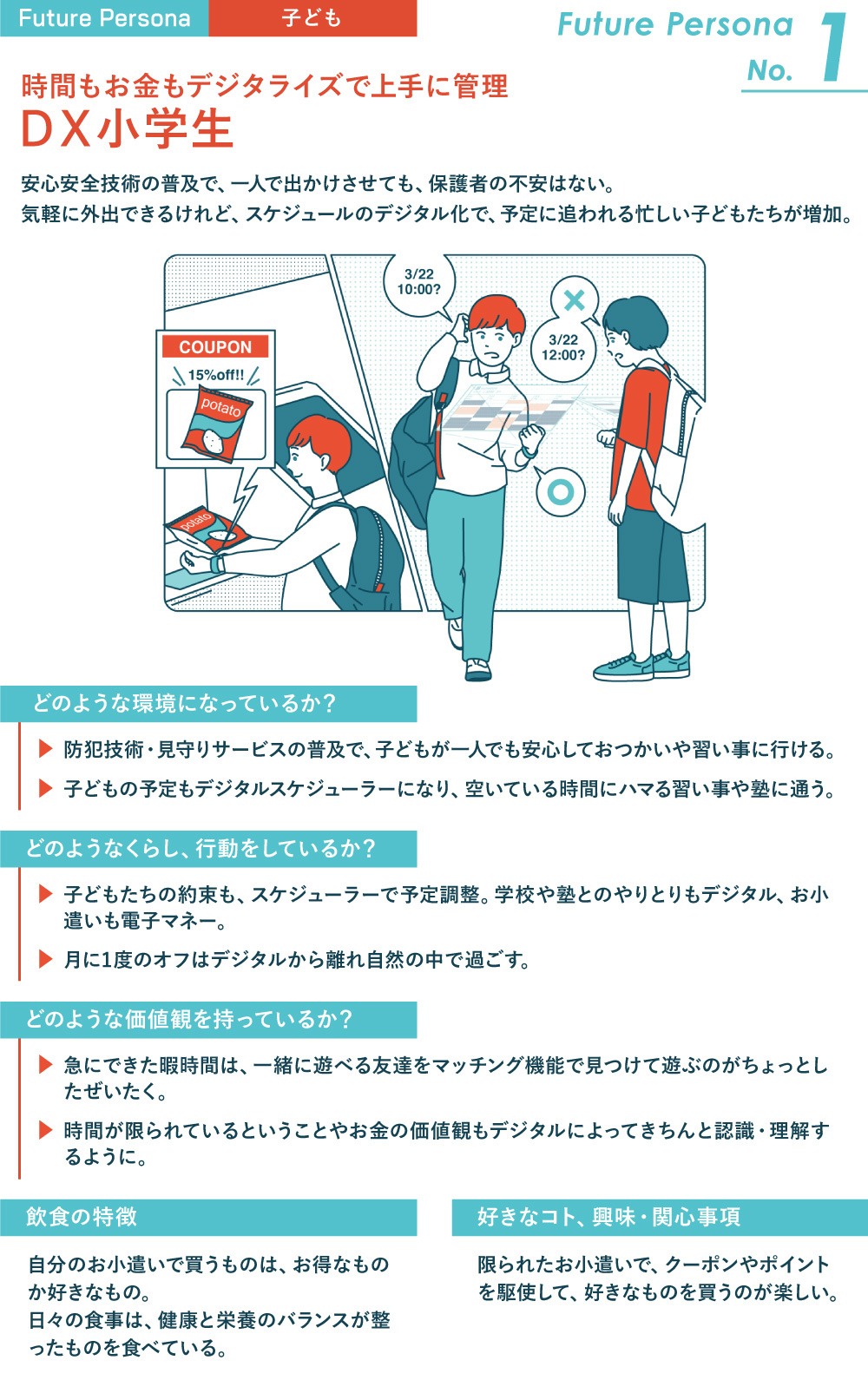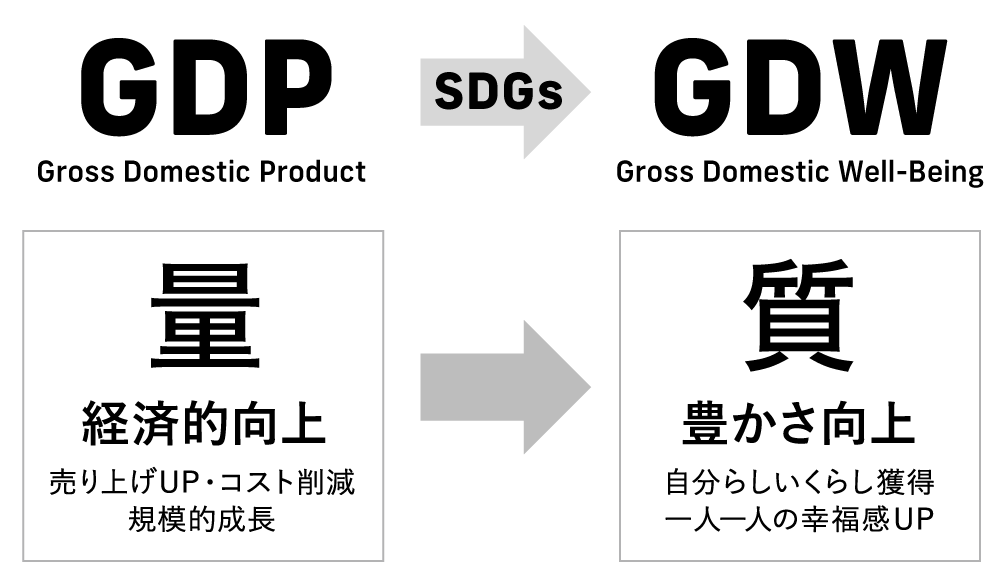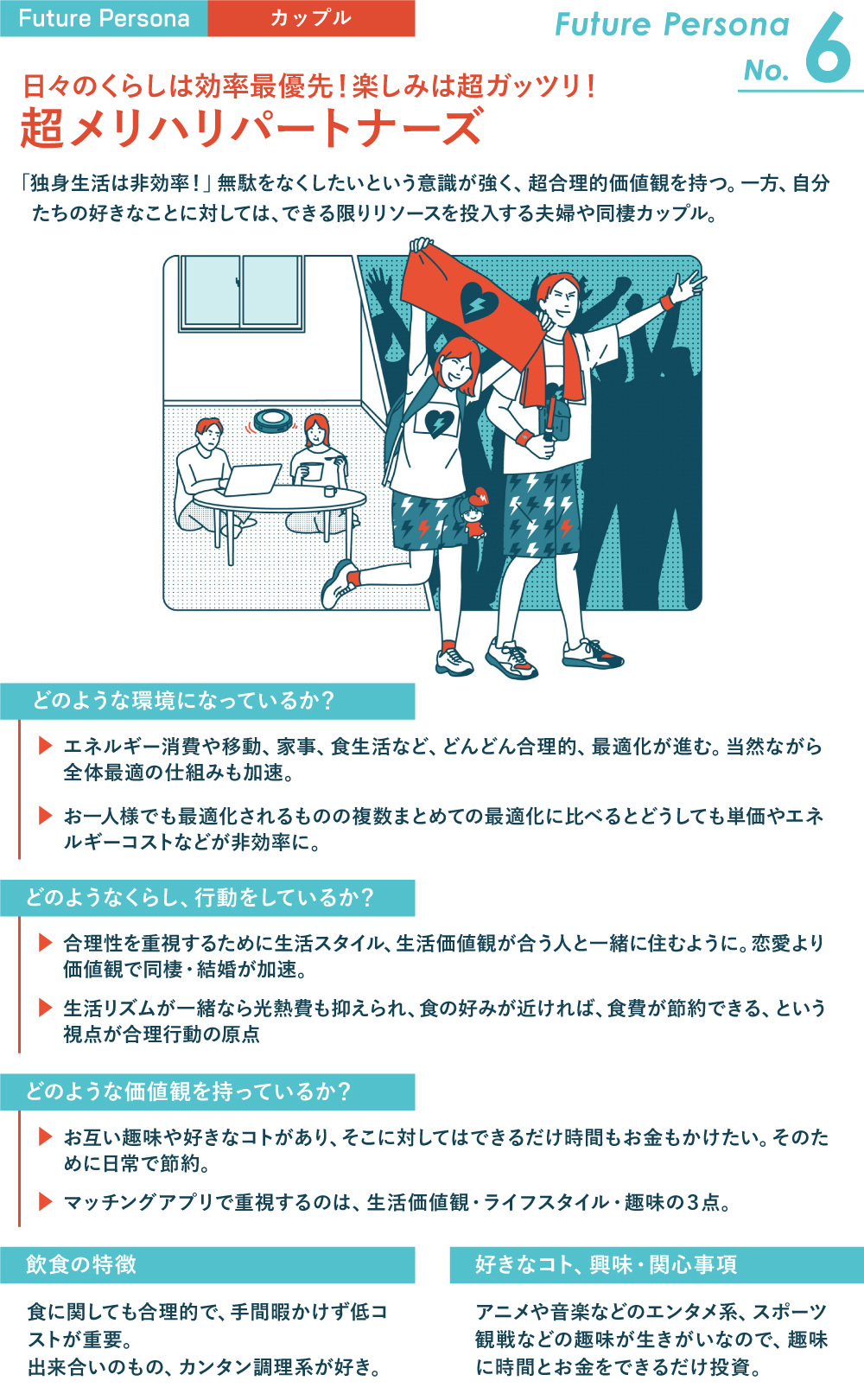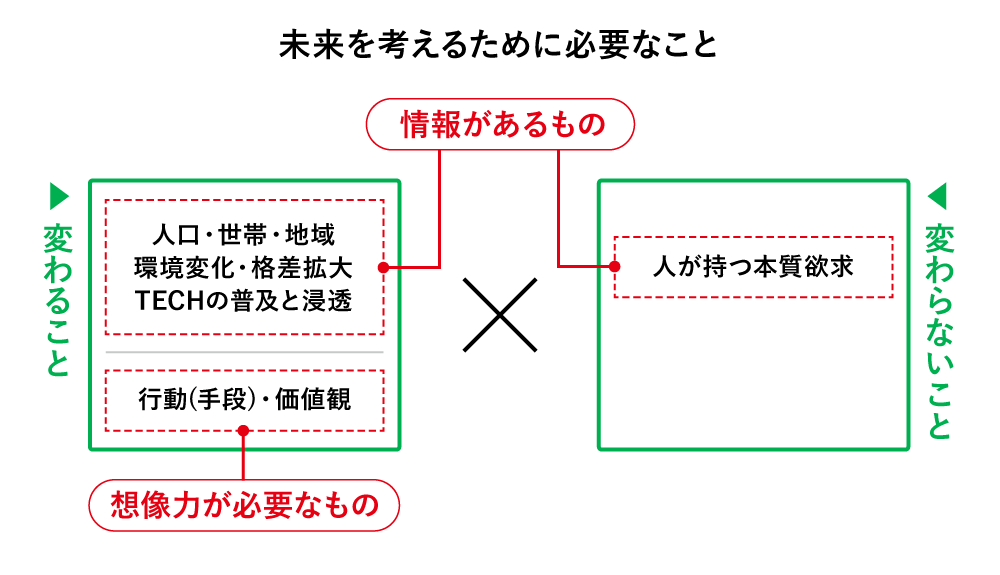From "Quantity" to "Quality": Visualizing the Future to Create New Services
In July 2021, we established the 'Future Business Creation Lab,' a cross-organizational unit within the Dentsu Group focused on future-oriented thinking to develop new businesses, purpose, and vision ( see release here ).
The background for this launch includes the shift from GDP (Gross Domestic Product) to GDW (Gross Domestic Well-being), reflecting the growing importance of individual well-being post-2030, following the period of SDG integration.
Particularly in Japan, with its declining population, tightening resources and energy, and waste issues, the era of mass production and mass consumption is becoming increasingly difficult to justify.
In deflationary Japan, there is also a need to shift towards a structure where value is delivered to those who need it, fair compensation is received, and proper profits are earned. In a sense, this is a concept close to branding.
While this mindset was developing beneath the surface, the COVID-19 pandemic brought to the forefront a trend affirming each individual's way of thinking and desired lifestyle. As the term "new normal" suggests, new lifestyles are spreading. However, what consumers can do is limited to choices within the current environment; they cannot create the necessary environment, products, or services for their desired way of life.
In response to this reality, we have decided to establish the Future Business Creation Research Institute to visualize the future and support companies in realizing business creation and transformation.
Considering Business Needs from the Perspective of "Ideal Living"
When creating businesses that leverage the future, it is crucial for companies and their employees to imagine what kind of life they can create to enrich society and people.
This means visualizing the vision of those involved in the project. In operating companies, the more talented the individual, the more likely they are to focus their thought process on developing business or product plans that will gain internal approval. The immediate demand is often what can be done now, not what will happen in five or ten years. Consequently, company circumstances tend to take precedence over the "desire" to create such a future.
This is where Future Business Creation Research proposes a backcasting approach starting from the "Ideal Future Lifestyle." We set aside current circumstances and visualize the "Ideal Future Lifestyle" – the vision of the kind of life we truly want to create. From there, we plan the necessary businesses and services to build that life. It's like a visionary entrepreneur founding a company by articulating their dream for the future.
Future Persona as a Visualization Method for the "Ideal Life"
Future Business Creation Research employs two visualization frameworks for the "ideal life." One is called the "Life Piece" framework, which captures scenes from daily life and visualizes their essence. Scenes are expressed through text and illustrations, making it immediately clear who is doing what and conveying the joy inherent in those moments.
<Life Piece Sample>
The other framework is "Future Persona." This depicts the future Ideal Target, meaning the image of the company's future customers. Like Life Piece, it depicts scenes of daily life, but to show what kind of people they are, it depicts characteristic scenes from the life of that person or those people.
Both Life Piece and Future Persona can be utilized in the same way. What actions are desirable to create such a lifestyle, and what is desirable as something these people would want or need, are determined in advance by aligning with the objectives.
This article introduces several Future Personas created within the Future Business Creation Lab last year. Since these were created internally, they are positioned more as "people likely to increase in the 2030s" rather than as Ideal Targets.
What does the "DX Elementary School Student" use and desire?
The first is the "DX Elementary School Student" Future Persona. While some elementary students already use smartphones proficiently today, smartphone ownership remains low among lower-grade students in terms of penetration rate. However, in the near future, even lower-grade elementary students will likely own smartphones and manage their schedules using digital schedulers. Beyond the internet, the metaverse will expand, enabling access to desired extracurricular activities regardless of location.
DNA analysis will reveal a child's traits and areas of high ability. They can try various activities to discover their potential before realizing what they truly want to pursue. Developing "their own identity" and "personal strengths" for the future will become crucial, promoting character education alongside academics. Consequently, more children will lead busy lives. But they're still kids—they want to play with friends and eat their favorite snacks. This Future Persona depicts such a child.

Looking at this Future Persona sheet, we want you to think about: "What does the DX elementary schooler want?" and "What services are they using?" Surely, their allowance is electronic money, leaving a full record of every purchase. They might get scolded for buying too many snacks or have their spending habits guided by AI.
Furthermore, their health might be monitored, and if they seem unwell or under the weather, their guardians could receive automatic notifications. They'll likely coordinate plans with friends using a digital scheduler. In some cases, their personal AI partner might even communicate with their friend's AI partner on their own, suggesting things like, "We can play here, what do you think?" The appeal of this approach is that it sparks many concrete ideas about what kind of "delight" to provide in which areas, and what services will become essential, in a future with such Future Personas.
"Hyper-Focused Partners" – A New Form of Shared Living
Let me introduce another Future Persona. While predictions suggest an increase in single individuals choosing not to marry, questions about the financial rationality of living alone are also expected to become more apparent. Options like shared housing exist, but people naturally want to spend time with those they feel comfortable with.
Therefore, we can expect an increase in living arrangements with new partners who share compatible values and hobbies, though not romantic partners. Living together reduces the burden of essential living costs. These individuals idealize a lifestyle where they enjoy shared hobbies together while remaining largely uninvolved in each other's personal affairs. The number of same-sex couples choosing this cohabitation model, avoiding the institution of marriage, may also grow.
Let's also consider what "Ultra-Balanced Partners" might seek. Since many likely want to avoid arguments over division of labor or who did or didn't do chores, more people will probably have robots handle household tasks. Not only fully automated appliances, but subscription-based housekeeping services will likely be popular. In some cases, demand for housing that includes such services might also increase.
Fundamentally, how people meet is also likely to change. In the future, seeking partners based on criteria rather than romance will become more accepted. These criteria might include spending habits—recording what money is spent on and how living expenses are managed—with matching systems based on this data potentially offering reassurance. Rather than just income, the trend toward valuing attitudes toward money and financial literacy is likely to grow.
The "Future CSV Approach" that derives new lifestyles = ideal ways of living

This future visualization framework has received high praise from many companies we've supported. While future forecasting is important, its appeal lies in visualizing what kind of future we can create and want to create based on that forecast, and sharing it with the team. It not only helps generate concrete business ideas—a fundamental challenge—but also serves as a valuable tool for verifying benefits and meaning (the envisioned future).
Now, let me introduce the unique methodology of the Future Business Creation Lab for visualizing the future of consumers.
To understand the future, we must grasp macro trends. This can be done by analyzing diverse information available online and future projections and possibilities published by government agencies.
Among these, the most reliable foundation is population trends and changes in age demographics. These are highly credible areas where predictions rarely deviate significantly. Additionally, changes in household structures, regional differences between urban and rural areas, environmental issues, climate change, and natural disasters are also relatively predictable domains. Equally or even more important than these are the technologies poised to profoundly transform daily life. Just as the internet and smartphones did before, robotics, AI, the metaverse, and the proliferation of sensors will be major factors moving forward.
Beyond forecasting these societal trends, the Future Business Creation Lab's unique "Future CSV Approach" leverages the Dentsu Group's strengths in consumer insights and future forecasting. This approach seeks to discover the "ideal lifestyle" that is comfortable for society, consumers, and businesses alike. By visualizing this "ideal lifestyle" through this methodology, we can clarify future value.
Dentsu Inc. possesses several unique knowledge assets for envisioning consumers' futures, one of which is Future Time Use (FTU), released on September 12, 2023 ( see release here ).
FTU is a tool that concretely depicts life ten years from now. It visualizes cohort analysis (※1) of media contact data collected annually, allowing users to see changes in daily life time for each gender and age group from their teens to their sixties, both currently and ten years ahead.
※1 = Cohort Analysis
An analytical method that separates factors influencing change from long-term continuous survey data into the effects of aging (age effect), the effects of the times (era effect), and the effects of generational differences (generational effect or cohort effect). A cohort refers to a group sharing the same birth year (or birth decade).
To envision the future, we must distinguish between what will change and what will remain constant. It is crucial to clearly identify where imagination or speculation is necessary. Furthermore, assuming everything will change or transform introduces too many variables, making the thinking process difficult.
Therefore, to envision the future desired by consumers beyond FTU, we prioritize people's "desires." We also conduct cohort analysis based on Dentsu Inc.'s long-term consumer survey data to calculate future desire scores. However, cross-referencing the number of desires with age groups becomes overly complex. To prioritize understanding and practical application, we define universal desires. In other words, our approach focuses on the fact that while desires themselves do not change, the actions taken to fulfill various desires do change, and the values tied to those desires shift with the times. We derive the actual state of each.
This time, we introduced two specific examples of Future Persona, one of the visualization frameworks within the Future Business Creation Lab's approach and methodology. In practice, since these represent future customer profiles, more emotionally resonant and distinctive Future Personas are often visualized.
When considering your vision, purpose, or new ventures, why not visualize the "reality of the future you want to create" and the "target persona"? We recommend this approach: establish your vision and purpose by defining the initiatives to build that future and the meaning behind it. This will surely help you establish new ideas unlike anything before and a strong will to create such a future!
Illustration: Tomomi Matsuyama











